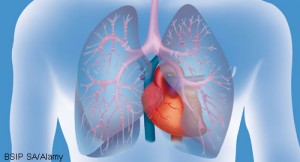 Many systemic sclerosis (SSc) patients may develop interstitial lung disease (ILD) and, despite a growing consensus that all patients with SSc should be screened with high-resolution chest computed tomography (CT), screening varies among rheumatology practices.1,2
Many systemic sclerosis (SSc) patients may develop interstitial lung disease (ILD) and, despite a growing consensus that all patients with SSc should be screened with high-resolution chest computed tomography (CT), screening varies among rheumatology practices.1,2
In March 2021, the U.S. Food & Drug Administration (FDA) approved tocilizumab to treat SSc-associated ILD. Tocilizumab, an anti-interleukin (IL) 6 agent, is the first biologic therapy to receive an indication for this condition. It also has indications for rheumatoid arthritis, giant cell arteritis, juvenile idiopathic arthritis and other rheumatologic conditions.
Tocilizumab Preserves Lung Function
The FDA approval of tocilizumab was based on data from two randomized controlled trials in patients with early SSc. The trials documented a large, clinically meaningful effect on forced vital capacity (FVC) and demonstrated tocilizumab preserved lung function in patients receiving therapy. This result stood in contrast to those of individuals in the placebo group, who experienced a large decline in lung function.3,4 However, the studies were limited because they did not describe radiographically evident, quantitative lung involvement.
Observational studies and clinical trials, such as the ones described above, have also shed light on the natural progression of SSc-associated ILD and the typical decline in FVC % associated with disease. In particular, the decline in the placebo group surprised experts because SSc-associated ILD is typically considered a slow progressive ILD. However, the trials documented a large and clinically meaningful average decline in FVC in the placebo group.
Focusing on Early SSC-Associated ILD
Recently, researchers reported the results of a post hoc analysis of patients from the focuSSced trial who were stratified by degree of lung involvement. The investigators used these data to analyze the effect of tocilizumab on lung function preservation in different subgroups and determine the relationship between degree of total lung involvement and fibrosis.
The researchers found patients with early SSc-associated ILD and progressive skin disease treated with tocilizumab demonstrated stabilized percent FVC at 48 weeks. The response described by David Roofeh, MD, a rheumatologist at the University of Michigan Health, Ann Arbor, Mich., and colleagues was independent of the extent of radiographically evident, quantitative ILD. The findings were published in the July issue of Arthritis & Rheumatology.4
The phase 3, multi-center, randomized, double-blind, placebo-controlled focuSSced trial, included patients with SSc who were at-risk for progressive ILD.5 All patients met the 2013 ACR/EULAR classification criteria and had disease onset of fewer than 60 months from the onset of their first non-Raynaud’s phenomenon sign or symptom, as well as a modified Rodnan skin score between 10 and 35. At baseline and week 48, the investigators performed baseline and serial spirometry along with high-resolution chest CT scans. Next, they used computer software to determine quantitative ILD and fibrosis scores. Using these baseline quantitative ILD scores, the researchers stratified patients into four groups: minimal (5% or less), mild (greater than 5–10%), moderate (greater than 10–20%) and severe (greater than 20%) lung involvement.
The Results
Of the 210 participants recruited for the study, only 30% had a history of ILD at baseline, whereas the investigators diagnosed 65% with ILD following uniform high-resolution chest CT scans. Most patients with ILD had moderate to severe lung involvement and approximately one-third of the patients in the trial had severe ILD.
